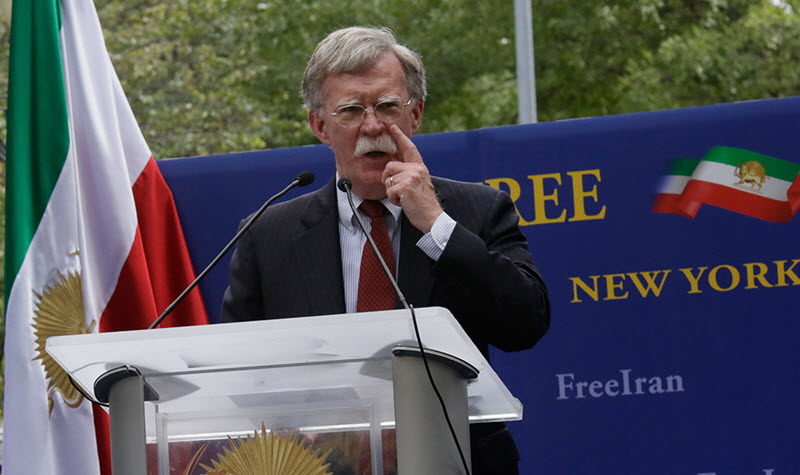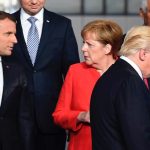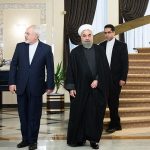by Assal Rad
Under the guise of weapons of mass destruction (WMDs) and ties to al-Qaeda, the Bush administration invaded Iraq in 2003—and the consequences have reverberated across the Middle East to this day. With the specter of war again on the horizon, striking parallels have emerged between the lead-up to the Iraq War and the current discourse on Iran. The media has parroted the Trump administration’s claims regarding Iranian “threats,” and U.S. media outlets continue to provide a pulpit for fringe Iranian opposition groups like the Mujahedin-e Khalq (MEK), a formerly designated terrorist organization.
Just as the Bush administration hinged their hopes of Saddam Hussein’s fall on the exiles of the Iraqi National Congress (INC) who duped U.S. officials with the now infamous “Curveball,”
Trump and his regime-change cabinet are now touting the MEK as a viable alternative to the current government in Iran. Despite these parallels, the mainstream media continues to give a platform to radical groups like the MEK, which are weaving together a questionable story to build a case for regime change and war with Iran.
Also similar to the INC, which claimed that it did not seek power in Iraq, the MEK pretends to work for democracy in Iran in the name of the Iranian people. Though both organizations have used fabrications to push their agenda, the tools of disinformation have evolved over time and the MEK has mastered the art of false narratives.
Coordinated efforts by small interest groups to undermine critics of Trump’s Iran policy and stifle pro-peace and pro-diplomacy voices have become increasingly hostile. Revelations have come to light on the role of the MEK in magnifying efforts at misrepresentation through inauthentic social media accounts aimed at manufacturing “Iranian” support for the Trump administration’s pro-war policies. The MEK also utilizes promoted content on news sites. For instance, The Hill is running a 10-week mini-series on Iran sponsored by the Organization of Iranian-American Communities (OIAC), a front group for the MEK.
Even more unsettling is the MEK’s creation of fake personas that publish in major U.S. outlets as a way to promote the pro-regime change narrative, falsely inflate support for war, and secure legitimacy as real “analysts.” Outlets such as Forbes and The Hill continue to host the writings of a person that is not real, a character created by the MEK called Heshmat Alavi.
Evidence of MEK machinations are substantiated by online campaigns intended to influence the narrative on Iran in favor of regime change. Former MEK members have confirmed the operation of MEK troll farms based in Albania, where members create thousands of inauthentic accounts and promote hashtags, propaganda, and tweets targeting anyone that favors diplomacy with Iran. The group also uses front organizations, like the OIAC, to take out paid ads that advance its cause at the expense of U.S. security interests in the region.
Despite its propaganda mission, the MEK is loathed inside Iran and has no support as an opposition force. Support for the fringe group fares no better in the Iranian diaspora. According to a 2018 poll among Iranian-Americans, only 6 percent said that they supported the MEK as a legitimate alternative to the current regime in Iran. The history of this enmity can be traced back to the Iran-Iraq War, when the MEK fought alongside Saddam Hussein.
The United States first placed the MEK on the Foreign Terrorist Organization list when the list was established in the 1990s based on their role in the murders of Iranians as well as Americans in bombings at U.S. companies in Iran in the 1970s. Since the Iranian Revolution of 1979, the MEK has continued to carry out assassinations and terror attacks inside Iran.
The group’s ideological premise is a subversion of Islam. In his seminal study of the history of the MEK, Ervand Abrahamian argues that it “developed an all-consuming hatred for the clerical regime and, at the same time, the burning conviction that its own radical version of Shiism was the one and only true interpretation of Islam.”
Although the MEK outwardly espouses human rights as a guiding principle, it is itself a cult-like group with a history of abuse and torture against its own members. According to a report by RAND, the group’s disturbing human rights cruelties against its members include physical abuse, seizure of assets, imprisonment, mandatory divorce, emotional isolation, and forced labor—to name but a few. Former MEK members who have escaped the group also report sexual abuse and forced marriages during their captivity. One of their more nefarious practices of authoritarian control over members is removing children from their parents.
The group’s removal from the terror list in 2012 was a result of a well-funded PR campaign led by paid spokespeople, including National Security Advisor John Bolton, who has received at least $40,000 in “speaking fees” from the group. Other members of the Trump team, such as his attorney Rudy Giuliani, have also received money from the MEK to lend their endorsement and speak at rallies calling for the overthrow of the Iranian government. The MEK has never revealed the source of its funding, although evidence suggests that Saudi Arabia may play an integral role in propping up the organization to manipulate U.S. policy and sow discord in Iran.
Ultimately, despite the parallels between the run-up to the Iraq War and today’s escalating tensions with Iran, the MEK and other radical faux-opposition forces with no legitimacy in Iran continue to be given platforms to propagate distorted Iran narratives. Despite the failures of the Iraq War, the experience seems to have done little to impel the mainstream media to produce more accurate, nuanced reporting.
Assal Rad is a research fellow at the National Iranian American Council. She received her PhD in History at the University of California, Irvine






Oh, Hanley, give me a break. The MEK is a bizarre and murderous cult with Miryam Rajavi as the cult leader. Ahmad Chalabi pales in comparison to her. Bolton and Giuliani are their paid fools. The US media has again all to often regurgitated the line of the war mongers in Washington, just as they did the lead up to the Iraq war. When the war started, of course, Chalabi and his few supporters supporters were shown up pretty quickly for the hucksters and corrupt fools they were. He had close to zero support in Iraq. As the saying goes, “Fool me once, shame on you. Fool me twice, shame on me.” I’ve had experience in Iran and with Iranian students abroad, some of which were members of the Rajavi cult. The latter were a sad group of people who were being taken to the cleaners.
@Hanley
Instead of making allegations and attacking Trita Parsi, how about providing links to “irrefutable” evidence. By the way please provide links to only reliable source, not more allegations from adversaries.
I was wondering what happened to Ali Mostofi? I’m very disappointed!
My thanks to Dr. Rad and Lobelog. This article is quite useful. United States has a long history of putting names in the terrorism list, then taking them off for political purposes or for money. Iraq’s Saddam Hussein is a great example of this behavior.
MEK is the group that open up the eyes of word on the Iranian nuclear ambitions, because of them the world realized abut nuclear activities of Iranian regime. About their support in Iran , they are the most supported group in Iran, the fact that Iranian regime has killed over 120,000 of the MEK members tells you that they have so many supporters. Iranian regimes focus on this group to divinize them . Talking about the speakers fee this is very norm for the speakers to get paid. The fact of the matter is if any speakers have speech in their event they knew who they are , “number one enemy of Iranian regime”.I am sure the Iranian regime paid for this article.